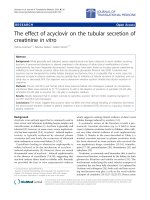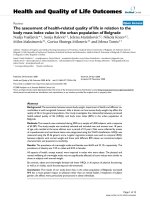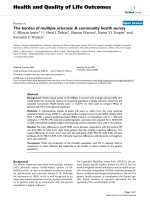Báo cáo hóa học: " The prevalence of polypharmacy in elderly attenders to an emergency department - a problem with a need for an effective solution" doc
Bạn đang xem bản rút gọn của tài liệu. Xem và tải ngay bản đầy đủ của tài liệu tại đây (124.83 KB, 3 trang )
ORIGINAL RESEARCH Open Access
The prevalence of polypharmacy in elderly
attenders to an emergency department - a
problem with a need for an effective solution
Ashis Banerjee
1*
, David Mbamalu
1
, Sayed Ebrahimi
1
, Arshad Ali Khan
1
and Toong Foo Chan
2
Abstract
We studied the prevalence of polypharmacy in attenders aged 75 years and over to an emergency department
(ED) in North London over a period of 1 month. We identified 467 patients in this age group. Analysis of
medications being prescribed revealed at least 82 patients on medication with the potential for adverse
interaction. There is a need for ED-initiated strategies to identify interactions and for pathways to allow for
medication review.
Introduction
Iatrogenic disease contributes significantly to morbidity
and mortality in the elderly population [1]. The ageing
population in the UK is steadily expanding, with asso-
ciated increased use of prescription medications. The
estimated resident population in the UK in mid-2009 was
61,792,000. Over the last 25 years the percentage of the
population aged 65 and over has increased by 1.7 million
from 15% in 1984 to 16% in 2009. By 2034, 23% of the
population is projected to be aged 65 and over compared
to 18% aged under 16. The fastest population rise has
been in those aged 85 and over, from 660,000 in 1984 to
1.4 million in 2009 [2]. Emergency department (ED)
attendances by those aged 75 years and over are also con-
tinuing to rise. It has been recognised that emergency
presentations may be influenced by the p rescription of
multiple drugs. The issue needs to be revisited as part of
the strategy to reduce increased pressures o n hospital
bed capacity in the UK, as there is a perception that
iatrogenic disease may contribute to avoidable admission.
These strategies should be expected to be extrapolated to
other health economies.
Therehasbeenasteadyriseintheuseofprescrip-
tion drugs in the over 60 age group in England since
1997, the overall number of prescriptions dispensed
during this period rising by nearly 60% [3]. In England,
796 million prescribed items were dispensed in 2007,
while 500 million items were dispensed in 1997. The
steepest rise in the period was in prescriptions for sta-
tins, from less than 5 million prescriptions in 1997 to
45 million in 2007. The costs of prescribing impose a
financial b urden on the NHS. At least 209 of our study
cohort of patients were receiving five or more pre-
scription drugs.
We set out to look at the prevalence of over-prescribing
in all patients aged 75 years and over attending our emer-
gency department in 1 month. We suggest possibl e solu-
tions, which warrant further exploration or enhancement.
Methods
Four independent physician reviewers were used for the
purposes of the study.
We used the Emergency Department computer system
(FirstNet) to identify all attendees, aged 75 years or over,
to the emergency department at Chase Farm Hospital,
Enfield, in north London during a period of 1 month. We
cross-checked the list thus obtained against that collected
by the liaison health visitor for patients aged 75 years of
age or over, which is funded by Enfield Primary Care
Trust the commissioners of the emergency service who
have a financial stake in obtaining accurate figures. The
health visitor reviews all patient ED records, and makes a
follow-up phone call within 1 to 3 days of attendance
where in dicated
* Correspondence:
1
Emergency Department, Chase Farm Hospital, The Ridgeway, Enfield EN 8JL,
Middlesex, UK
Full list of author information is available at the end of the article
Banerjee et al. International Journal of Emergency Medicine 2011, 4:22
/>© 2011 Banerjee et al; licensee Springer. This is an Open Access articl e distributed unde r the terms of the Creative Comm ons
Attribution License ( which permits unrestricted use, distribution, and reproduction in
any medium, provided the original work is properly cited.
We extracted the following information, using a struc-
tured form, in patients aged 75 years or over attending
the ED:
• Hospital number
• Date of birth
• Sex
• Presenting symptom (s)
• Current medication list (names and dosages)
• History of fall at presentation or of recurrent falls
in the past
• Disposal outcome
We defined polypharmacy as the use of five or more
prescription medications, as this definition is used in the
North Central London region hospitals as the working
definition for identifying risk factor s for falls clinic refer-
rals. There is no currently accepted international consen-
sus definition of polypharmacy [4,5]. We furthermore
looked at the potential for drug interactions, guided by
the British National Formulary appendix on interactions
and by the Beers criteria [6].
Results
The period of data collection was from 10 June to 10 July
2008. The total number of patients aged 75 years and
over at tending during this period was 467, with 265
females and 202 males. The age range was f rom 75 to
101 years, with a median age of 88 years. Of the patients,
209 (45%) were on five or more prescription drugs (see
Table 1); 127 (27%) were either on no medication or had
no drug history recorded in the notes. Non-recording of
medication in the minors (ambulatory care area) was
recognised to be an issue, usually in patients with minor
injuries requiring a relatively brief intervention, who
numbered 68. It is possible that this under-recording led
to underestimation of the prevalence of polypharmacy.
One hundred five patients (22%) presented with a fall,
whichwasthemostfrequentpresentingcomplaint.
Other presenting complaints were shortness of breath
(57; 12%), chest pain (25; 5%), abdomin al pain (19; 4%),
confusion (17; 3.6%), being unwell (36; 7.7%) and col-
lapse (15; 3.2%).
Of the patients on five or more documented prescription
medications, 82 (39%) were on combinations that had the
potential for adverse reactions. The majority related to
hypotensive effects of varying combinations of ACE inhibi-
tors, loop diuretics and calcium channel blockers.
Although warfarin is used in a significant number of
elderly patients, we were unable to find any drug combina-
tions leading to potential adverse interaction with warfarin
usage. This may be because of the close level of monitor-
ing of therapeutic anticoagulation in dedicated anticoagu-
lation clinics in the hospital, and of wider awareness of the
potential for drug interactions with warfarin.
Discussion
The demography of the UK population is changing.
Currently, one fifth of the UK population is 60 years or
older. Increasing age is associated with changes in phar-
macokinetics and pharmacodynamics, affecting the
absorption, distribution, metabolism a nd excretion of
drugs [7]. The altered physiology of old age is related to
reduced total body water, reduced lean body mass and
body fat, reduced serum albumin and altered protein
binding, reduced liver phase one metabolism, reduced
renal plasma flow, reduced glomerular filtration rate and
renal clearance.
A meta-analysis identified that around 20% of people
over 70 take five or more drugs [8]. These drugs are
usually prescribed for co-morbidities resulting from
musculoskeletal, cardiovascular, gastrointestinal, neuro-
logical and urological disorders. Polypharmacy is asso-
ciated with increases in drug-drug interactions, adverse
drug reactions, disease-drug interactions and food-drug
interactions. There is also a n increase in prevalence of
falls [9], hospital admission rates, lengths of hospital
stay, readmission rates and mortality rate. Associated
problems include medication a dministration errors and
poor compliance.
Adverse drug reactions can either singly or in combi-
nation precipitate an emergency department visit. They
include confusion, electrolyte disorders, gait disorder
and falls, postural hypotension and falls, gastrointestinal
bleeding, incontinence, hypothermia and constipation
[7].
Table 1 Range of numbers of prescribed medications in
study population
Number of prescription drugs Number of patients
126
229
335
441
540
636
734
827
922
10 19
11 11
12 6
13 4
14 6
15 1
16 1
17 2
Banerjee et al. International Journal of Emergency Medicine 2011, 4:22
/>Page 2 of 3
In our study, 82 patients prescribed five or more pre-
scription medications had the potential for adverse drug
reactions. However, our study design does not allow for
correlation of polypharmacy with the presenting com-
plaint, as data we re collected retrospectively and also
because for any given presentati on there may be the
coexistence of multiple factors contributing to the pre-
sentation. The study highlights the emergency depart-
ment as a place where potential drug interactions can
be identified in high-risk elderly attenders.
The emergency department provides an environment
in which polypharmacy can be identified, including its
role in precipitating hospital attendance , leading to cor-
rective action being initiated, particularly in patients
being sent home [10]. In the current climate of bed
shortages, emergency department gridlock and admis-
sion avoidance schemes, the presence of a, ED pharma-
cist would be of potential benefit to the process of
identification of drug interactions [11,12]. Furthermore,
rational prescribing for the elderly should be guided by
consensus criteria, such as those developed in the US by
Delphic methodology [13]. These essentially involve list-
ing potentially inappropriate medications, where the
risks of administration may outweigh the ben efits of
administration.
In our own population, we suggest more effective sur-
veilla nce of prescript ion medicat ion in elderly attenders
to the ED, and the need for mechanisms to detect the
need for, and achieve, corrective action where indicated.
Potential strategies Box 1
• Medication review for all ED attenders, aided by
dedicated ED pharmacist sessions
• IT-based solutions to highlight potential drug
interactions: electronic prescribing support systems
• Effective prescription monitoring in the
community
• Targeted feedback to general practition ers to con-
sider reducing prescription medication via care of
elderly liaison health visitor
• Effe ctive case management of chronic disease i n
the community
• Awareness of risk-inducing prescriptions (box 2)
Examples of drugs that pose a particular risk for
older people Box 2
• Long term non-steroidal anti-inflammatory drugs
• Long-acting benzodiazepines, e.g. diazepam
• Anti-cholinergic drugs
• Tricyclic antidepressants
• Doxazosin
• Metoclopramide
Author details
1
Emergency Department, Chase Farm Hospital, The Ridgeway, Enfield EN 8JL,
Middlesex, UK
2
Barnet & Chase Farm Hospitals Trust, Chase Farm Hospital,
Enfield, Middlesex, UK
Authors’ contributions
AB conceived the idea for the study; AB and DM designed the study and
the data collection proforma; TFC assisted with collation of the data; AB, DM,
AAK and SE actively collected the data from the departmental records. All
the data have been verified by DM and AB.
Authors’ information
Ashis Banerjee has been a consul tant in emergency medicine in London for
the preceding 16 years, and is lead clinician at Chase Farm Hospital and
honorary senior lecturer at University College London Medical School.
David Mbamalu is a consultant in emergency medicine at Chase Farm
Hospital, Enfield.
Sayed Ebrahimi and Arshad Ali Khan are specialty doctors in emergency
medicine at Chase Farm Hospital, Enfield.
T.F. Chan is chief pharmacist at Chase Farm Hospital, Enfield.
Competing interests
The authors declare that they have no competing interests.
Received: 4 November 2009 Accepted: 2 June 2011
Published: 2 June 2011
References
1. JM Rothschild, DW Bates, LL Leape, Preventable medical injuries in older
patients. Arch Intern Med. 160, 2717–2728 (2000). doi:10.1001/
archinte.160.18.2717
2. Office for National Statistics, />aspżID=949
3. Prescriptions Dispensed in the Community - Statistics for 1997-2007,
(England)
4. RL Bushardt, EB Massey, TW Simpson., et al, Polypharmacy: Misleading, but
manageable. Clin Interv Aging. 3, 383–389 (2008)
5. NA Masoodi, Polypharmacy: To err is human, to correct divine. BJMP. 1,6–9
(2008)
6. MH Beers, Explicit criteria for determining potentially inappropriate
medication use by the elderly. Arch Intern Med. 157, 1531– 1536 (1997).
doi:10.1001/archinte.157.14.1531
7. JC Milton, I Hill-Smith, SHD Jackson, Prescribing for older people. BMJ. 336,
606–609 (2008). doi:10.1136/bmj.39503.424653.80
8. V Rollason, N Vogt, Reduction of polypharmacy in the elderly: a systemic
review of the role of the pharmacist. Drugs Aging. 20, 817–832 (2003).
doi:10.2165/00002512-200320110-00003
9. G Ziere, JP Dieleman, A Hofman., et al, Polypharmacy and falls in the
middle age and elderly population. Br J Clin Pharmacol. 61, 218–223 (2005)
10. KM Prybys, KA Melville, JR Hanna, Polypharmacy in the elderly: Clinical
challenges in emergency practice: II: High-risk drugs, diagnosis, and the role
of the emergency physician. Emerg Med Rep. 23, 12 (2002)
11. RJ Fairbanks, JM Hildebrand, KE Kolstee, SM Schneider, MN Shah, Medical
and nursing staff highly value clinical pharmacists in the emergency
department. Emerg Med J. 24, 716–718 (2007). doi:10.1136/emj.2006.044313
12. JM Rothschild, W Churchill, A Erickson., et al, Medication errors recovered
by emergency department pharmacists. Ann Emerg Med. 55, 513–521
(2010). doi:10.1016/j.annemergmed.2009.10.012
13. DM Fick, JW Cooper, WE Wade., et al, Updating the Beers criteria for
potentially inappropriate medication use in older adults: Results of a US
Consensus Panel of Experts. Arch Intern Med. 163, 2716–2724 (2003).
doi:10.1001/archinte.163.22.2716
doi:10.1186/1865-1380-4-22
Cite this article as: Banerjee et al.: The prevalence of polypharmacy in
elderly attenders to an emergency department - a problem with a
need for an effective solution. International Journal of Emergency Medicine
2011 4:22.
Banerjee et al. International Journal of Emergency Medicine 2011, 4:22
/>Page 3 of 3









